CC 05: Global Snapshot

이번시간에는 Distributed Snapshot 에 대해서 배웁니다. 클라우드 환경에서 각 어플리케이션(혹은 서비스) 는 여러개의 서버 위에서 돌아갑니다. 각 서버는 concurrent events 를 다루며, 서로 상호작용합니다. 이런 환경에서 global snapshot 을 캡쳐할 수 있다면
- check pointing: can restart distributed application on failure
- garbage collection of objects: object at servers that don’t have any other objects(ay any servers) with pointers to them
- deadlock detection: useful in database transaction systems
- termination of computation: useful in batch computing systems like Folding@Homes, SETI@Home
global snapshot 은 두 가지를 포함합니다.
(1) Individual state of each process (2) Individual state of each communication channel
global snapshot 을 만드는 한가지 방법은 모든 프로세스의 clock 을 동기화 하는 것입니다. 그래서 모든 프로세스에게 time t 에서의 자신의 상태를 기록하도록 요구할 수 있습니다. 그러나
- Time synchorization always has error
- Doesn’t not record the state of meesages in the channels
지난 시간에 보았듯이, synchronization 이 아니라 casuality 로도 충분합니다. 프로세스가 명령을 실행하거나, 메시지를 받거나, 메시지를 보낼때마다 global system 가 변합니다. 이를 저장하기 위해서 casuality 를 기록하는 방법을 알아보겠습니다.
Chandy-Lamport Algorithm
시작 전에 system model 을 정의하면
- N Processes in the system
- There are two uni-directional communication channels between each ordered process pair
P_j -> P_i,P_i -> P_j - communication channels are FIFO ordered
- No failure
- All messages arribe intact, and are not duplicated
requirements 는
- snapshot 때문에 application 의 작업에 방해가 일어나서는 안됩니다
- 각 프로세스는 자신의 state 를 저장할 수 있어야 합니다
- global state 는 분산회되어 저장됩니다 (collected in a distributed manner)
- 어떤 프로세스든지, snapshot 작업을 시작할 수 있습니다
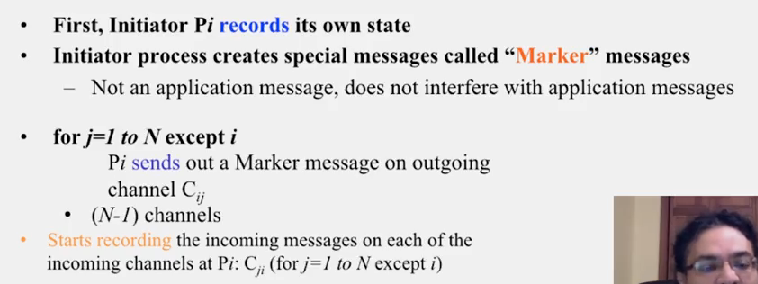
- 프로세스
P_i가 market 메세지를 만들고, 자신을 제외한 다른N-1개의 프로세스에게 보냅니다 - 동시에
P_i는 incoming channel 을 레코딩하기 시작합니다
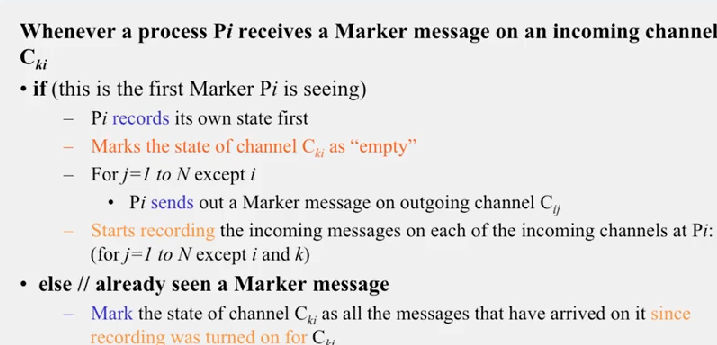
(1) 만약 P_i 가 marker 메시지를 처음 받는다면
- 만약메시지를 받은 프로세스
P_i에서는 자신의 state 를 기록하고 - 자신을 제외한 프로세스들에게 marker 보내고
- 는 incoming channel 을 레코딩하기 시작합니다
(2) P_i 가 이미 market 메세지를 받은적이 있다면
- 이미 해당 채널의 모든 메세지를 기록중이었으므로, 레코딩을 끝냅니다
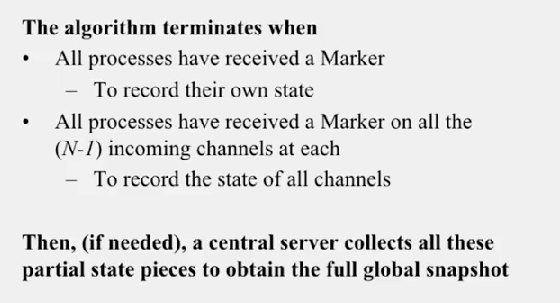
이 알고리즘은 모든 프로세스가 자신의 state 와 모든 channel 을 저장하면 종료됩니다.
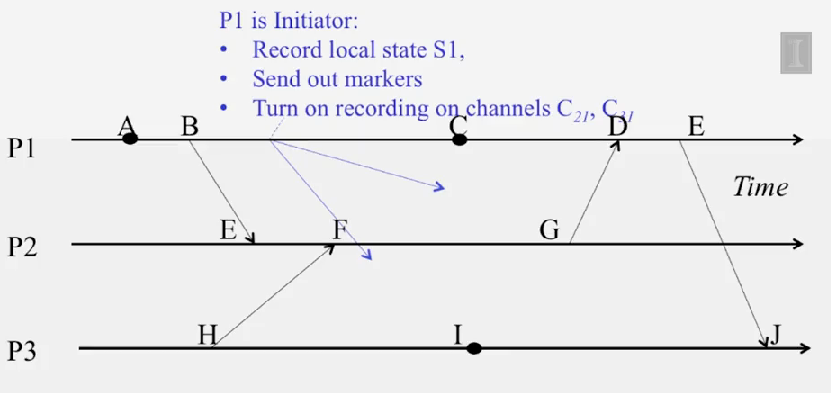
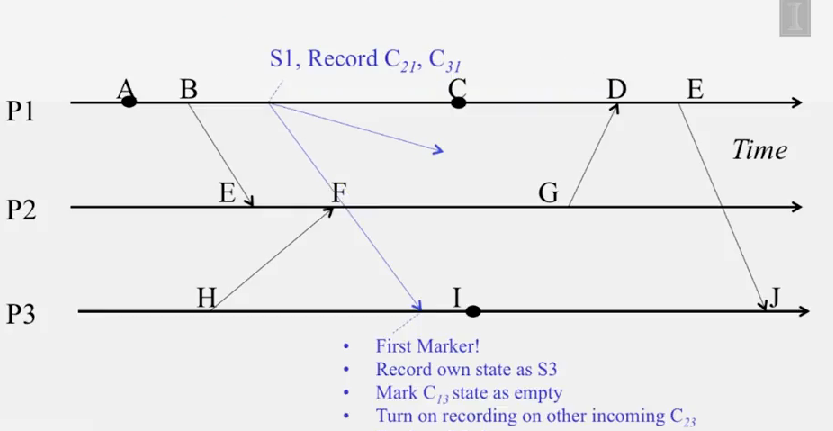
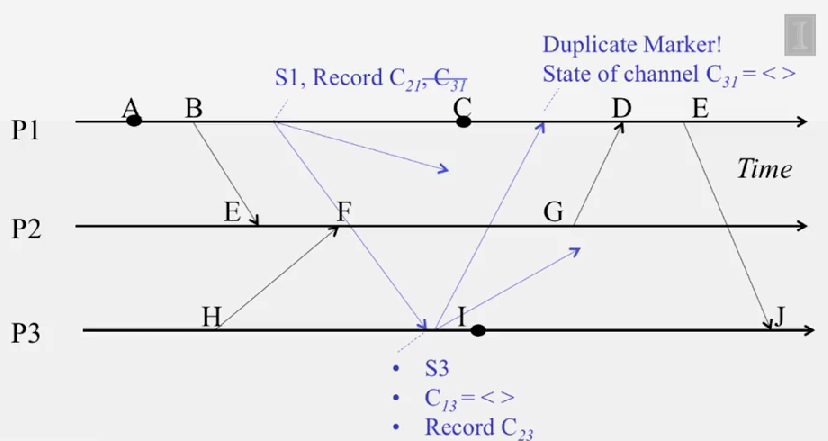
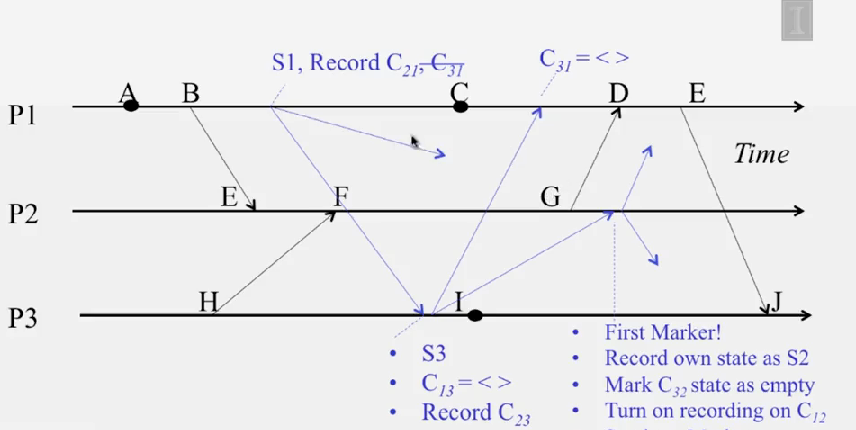
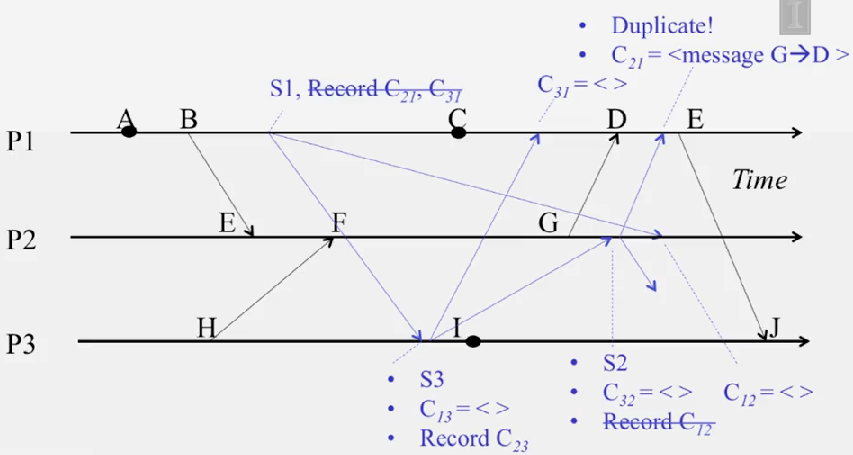
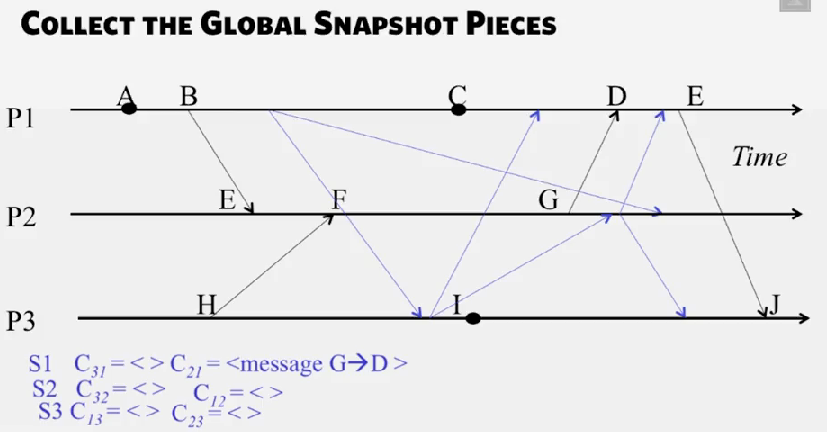
Consistent Cuts
Chandy-Lamport 알고리즘은 casuality 를 보장합니다. 이에 대해 증명하기 전에 먼저, consistent cut 이란 개념을 보고 가겠습니다.
Cut: time frontier at each process and at each channel. Events at the process/channel that happen before the cut are in the cut and happening after the cut are out of the cut
Consistent Cut: a cut that obeys casuality. A cut
Cis a consistent cut iff for each pair of eventefin the system, such that eventeis in the curCand iff -> e
다시 말해서 e 가 C 내에 있고, f -> e 라면 f 도 C 에 있어야만 consistent cut 이란 뜻입니다.
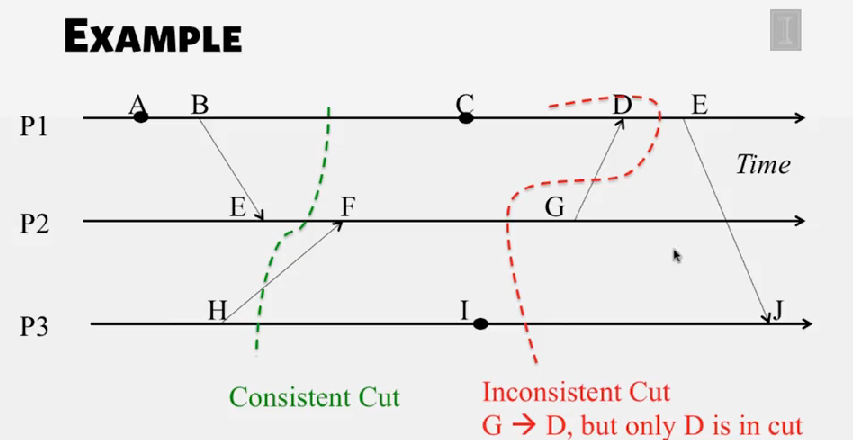
F 가 cut 내에 있지만, 올바르게 캡쳐되어 메시지 큐 내에서 전송중임을 snapshot 에서 보장합니다. 하지만 G -> D 같은 경우는, D 가 cut 내에 있지만 G 가 그렇지 않아 inconsistent cut 입니다.
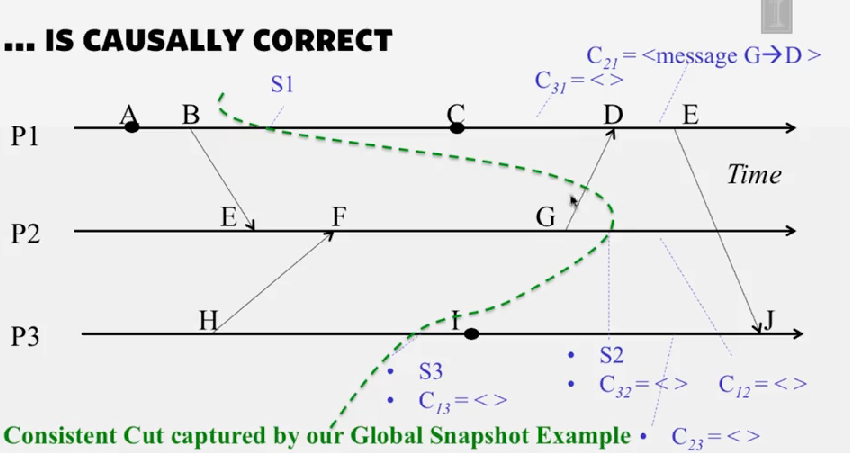
Chandy-Lamport Global Snapshot 알고리즘은 항상 consistent cut 을 만듭니다. 왜 그런가 증명을 보면
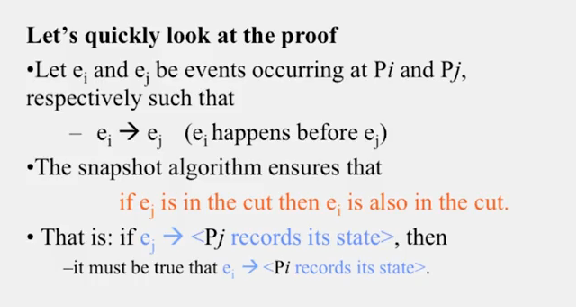
ei -> ej 를 보장한다는 말은 스냅샷 안에 두 이벤트가 있다는 뜻입니다. 따라서 ej -> <P_j records its state> 일때 당연히 ei -> <P_i records its state> 와 같은 말입니다.
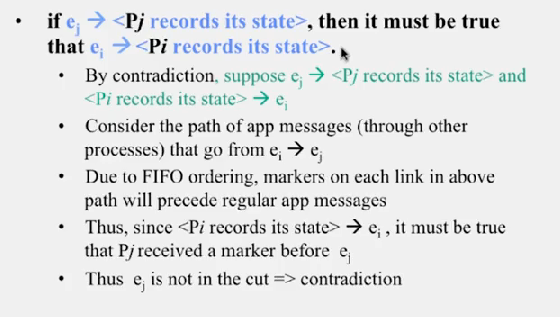
만약 ej -> <P_j records its state> 일때 <P_i records its state> -> ei 라 합시다.
그러면 ei -> ej 로 가는 regular app message 경로를 생각해 봤을때, P_i 가 먼저 자신의 상태를 기록하기 시작했으므로 marker 메세지가 먼저 날라갈겁니다. (FIFO) 그러면 위에서 말한 ei -> ej 경로를 타고 marker 메세지가 먼저 가게되고 P_j 는 자신의 상태를 먼저 기록하게 됩니다. 따라서 P_j 에서 ej 보다 자신의 상태를 기록하는 것이 먼저이므로 ej 는 out of cut 이고, 모순입니다.
Safety and Liveness
분산시스템의 correctness 와 관련해서 safety 와 liveness 란 개념이 있습니다. 이 둘은 주로 혼동되어 사용되는데, 둘을 구별하는 것은 매우 중요합니다.
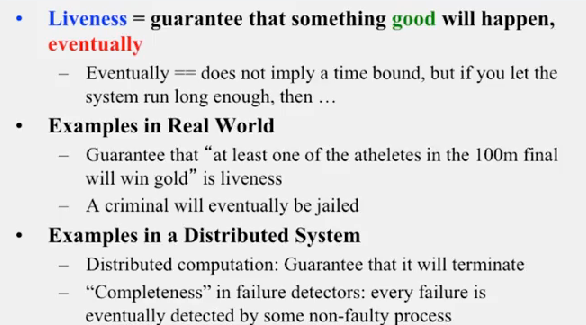
- distributed computation will terminate eventually
- every failure is eventually deteced by some non-faulty process
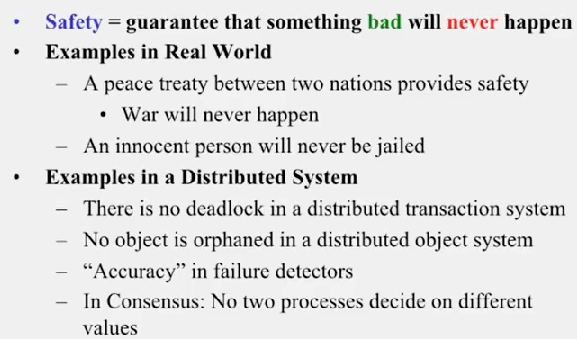
- there is no deadlock in a distributed transaction system
- no object is orphaned
- accuracy in failure detector
- no two processes decide on different values
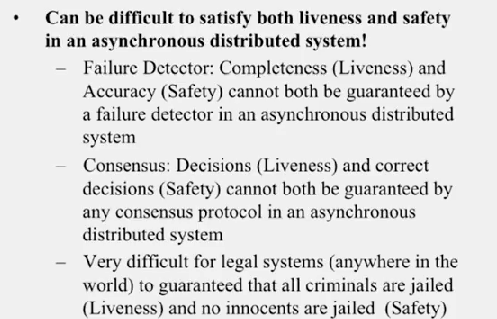
failure detector 나 concensus 의 경우에서 볼 수 있듯이 completeness 와 accuracy 두 가지를 모두 충족하긴 힘듭니다.
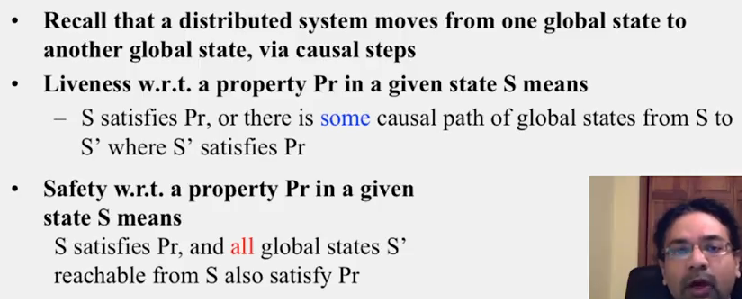
global snapshot 은 한 상태 S 이고, 여기서 다른 스냅샷으로의 이동은 casual step 을 따라 이동하는 것입니다. 따라서 liveness 와, safety 와 관련해 다음과 같은 특징이 있습니다.
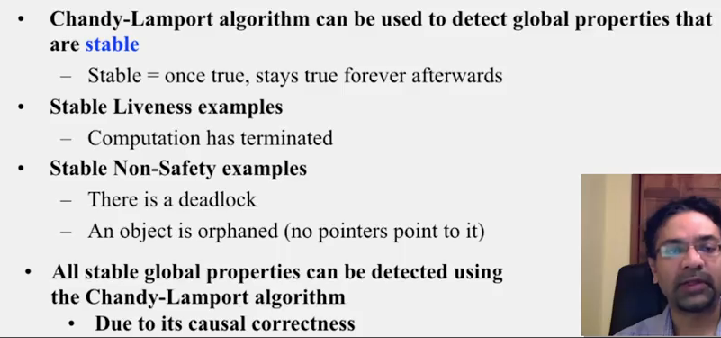
Chandy-Lamport 알고리즘은 stable 한지를 검사하기 위해 사용할 수도 있습니다. 여기서 stable 하다는 것은, 한번 참이면 그 이후에는 계속 참인 것을 말합니다. 이는 알고리즘이 casual correctness 를 가지기 때문입니다.
Refs
(1) Title Image
(2) Cloud Computing Concept 1 by Indranil Gupta, Coursera
comments powered by Disqus